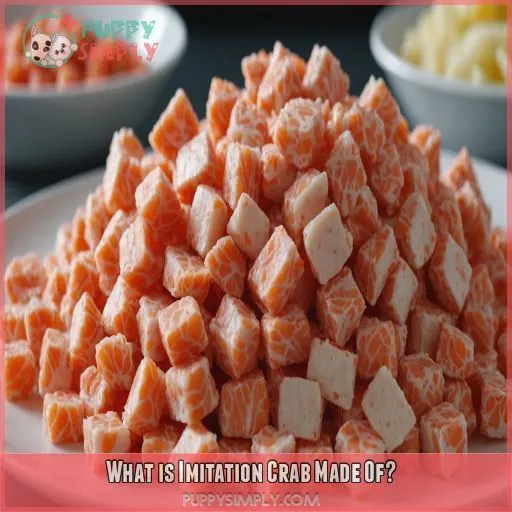This site is supported by our readers. We may earn a commission, at no cost to you, if you purchase through links.
 You’re wondering if your furry friend can snack on fake crab meat?
You’re wondering if your furry friend can snack on fake crab meat?
Sorry to burst the bubble, but it’s not the best idea.
Imitation crab meat, often made from surimi, a fish paste, contains starches, sugars, and additives that can be problematic for dogs.
The stringy texture poses a choking hazard, and its high sodium content can lead to electrolyte imbalances.
Also, some dogs may be allergic to fish proteins or other seafood ingredients.
So, while it may seem like a harmless treat, it’s better to steer clear of fake crab meat for your pup’s safety.
There’s more to explore on this topic!
Table Of Contents
- Key Takeaways
- Can Dogs Eat Fake Crab Meat?
- Is Imitation Crab Good for Dogs?
- Risks Associated With Feeding Dogs Imitation Crab Meat
- What is Imitation Crab Made Of?
- Safe Alternatives to Crab Meat for Dogs
- Managing Allergies and Sensitivities in Dogs
- Maintaining a Healthy Diet for Your Dog
- Frequently Asked Questions (FAQs)
- Can you give a dog imitation crab meat?
- Can dogs be allergic to imitation crab?
- Can dogs eat fake meat?
- What is imitation crab made of?
- Can dogs develop allergies from eating imitation crab frequently?
- Is it safe for dogs to eat hairy crab sticks?
- Can dogs eat imitation crab if they have shellfish allergies?
- How much imitation crab can dogs safely eat per week?
- Can puppies eat imitation crab meat as an occasional treat?
- Conclusion
Key Takeaways
- Don’t risk it! Fake crab meat is a choking hazard, and its stringy texture can easily get stuck in your dog’s throat or digestive tract. Instead, Instead, opt for safe alternatives like cooked, boneless chicken or Basil Pesto Variations.
, boneless chicken or green beans.
- You’ll want to keep an eye on those ingredients! Fake crab meat is often made from surimi (a fish paste), starches, sugars, and additives that can be problematic for dogs. Some dogs may be allergic to fish proteins or other seafood ingredients, so it’s best to steer clear.
- If you’re considering fake crab meat as an occasional treat, remember that moderation is key. Start with a small serving size and balance it with a nutrient-rich dog food to avoid sodium overload and digestive issues.
- If your furry friend has a shellfish allergy, it’s best to avoid fake crab meat altogether. Even if some brands claim to be shellfish-free, it’s not worth the risk of an allergic reaction. Consult your vet for advice on safe alternatives that will keep your pup happy and healthy.
Can Dogs Eat Fake Crab Meat?
You’re considering giving your furry friend some fake crab meat, but before you do, let’s get the lowdown on whether it’s safe for them to chow down. From its composition to potential health risks, we’ll explore the ins and outs of imitation crab meat for dogs, so you can make an informed decision about what’s best for your pup.
Definition and Composition of Imitation Crab Meat
You’re wondering if fake crab meat is safe for your furry friend? Let’s take a closer look at what imitation crab meat is made of. Here are 4 key things to know:
- Fish paste: It’s usually made from surimi, a fish paste made from pollock or other white fish.
- Starches and sugars: These are added to enhance texture and flavor.
- Vegetable proteins: Some imitation crab meat contains plant-based proteins like pea or soy protein.
- Additives and preservatives: These can include artificial flavorings, colors, and sodium.
Comparison to Real Crab Meat
When comparing fake crab meat to the real deal, there are some key differences to keep in mind. Real crab meat has a richer taste and firmer texture, while imitation crab meat is often softer and milder in flavor. Additionally, real crab meat generally has a higher nutritional value and is more expensive, but also less sustainable.
Process of Making Surimi
Let’s talk surimi – the meat behind imitation crab. To make surimi, fish is pulverized, reformed, and flavored to mimic crab texture and taste. Here’s a breakdown:
- Fish processing: removing bones, skin, and fat
- Texture creation: adding starches, sugars, and egg whites
- Flavoring process: mixing in natural and artificial flavorings
- Surimi applications: forming into crab-like flakes or chunks
Is Imitation Crab Good for Dogs?
You’re probably wondering if imitation crab is a safe and healthy treat for your furry friend. While it’s not entirely off-limits, there are some things you should know before serving it up to your pup.
Nutritional Value of Imitation Crab Meat
If you’re curious about imitation crab meat, you’re probably wondering what’s really in it. Let’s break it down. Imitation crab is made from surimi, a fish-based protein source, and often contains fillers like starch, sugar, and sodium. Here’s a snapshot of its nutritional value:
| Nutrient | Imitation Crab Meat |
|---|---|
| Protein | 10-15% |
| Sodium | 200-300mg per 3 oz serving |
| Fat | 1-3% |
Keep in mind, these values can vary depending on the brand and ingredients used.
Potential Health Benefits for Dogs
Now that you know the nutritional value of imitation crab meat, let’s explore its potential health benefits for your furry friend. Imitation crab can be a nutritious addition to your dog’s diet, providing:
- Omega-3 benefits for healthy skin and coat
- A protein source for muscle growth and repair
- Joint health support
- Immune system boost
- A tasty alternative to traditional dog treats
Importance of Moderation in Feeding Imitation Crab
Regarding feeding your furry friend imitation crab, moderation is key. While it can be a tasty treat, overdoing it can lead to sodium overload and digestive issues. Consider your dog’s age, size, and dietary needs, and start with a small serving size. Don’t rely on imitation crab as a staple – balance it with a nutrient-rich dog food.
Risks Associated With Feeding Dogs Imitation Crab Meat
As you consider adding imitation crab meat to your dog’s menu, it’s important to be aware of the potential risks involved. From allergic reactions and digestive upsets to choking hazards and additional health concerns, there are several reasons why you might want to think twice before serving fake crab to your furry friend.
Allergic Reactions and Digestive Upsets
The dreaded allergy alert! As a responsible dog parent, you want to know if imitation crab meat is safe for your furry friend. Here are 5 potential allergens to watch out for:
- Fish proteins (common in seafood allergies)
- Wheat and gluten (often used as fillers)
- Soy and egg (may cause digestive upset)
- Food additives (can trigger sensitivities)
- Other seafood ingredients (like shellfish)
Choking Hazards Due to Its Texture
Ever stopped to think about the texture of imitation crab meat? Its stringy, Its stringy, fibrous consistency can be a serious choking hazard for dogs
. When consumed, it can easily get stuck in their throat or digestive tract. To avoid this risk, consider safe alternatives like cooked, boneless chicken or green beans, To avoid this risk, consider safe alternatives like cooked, boneless chicken or green beans, which are gentler on your dog’s digestive system, unlike high sodium foods.
.
Additional Health Risks
Now that we’ve covered the choking hazards of imitation crab meat, Now that we’ve covered the choking hazards of imitation crab meat, let’s tackle the additional health risks, similar to those associated with Mochi Ice Cream Risks.
. You might be wondering, what else could possibly go wrong? Well, here are four more concerns:
- Sodium overload: Imitation crab meat is high in sodium, which can lead to electrolyte imbalances.
- Iodine excess: Too much iodine can cause thyroid problems in dogs.
- Additives and fillers: Artificial flavors, potassium chloride, and other additives can be toxic to dogs.
- Nutrient imbalances: Imitation crab meat can disrupt your dog’s delicate nutrient balance, leading to a range of health issues.
What is Imitation Crab Made Of?
You’re probably wondering what’s really in that imitation crab meat, and whether it’s safe for your furry friend to snack on. Let’s take a closer look at the common ingredients used to make fake crab meat, and how they might affect your dog’s digestive system.
Common Ingredients Used in Imitation Crab Meat
If you’re curious about imitation crab meat, you’re probably wondering what’s really in it. Well, let’s break it down. Imitation crab meat is typically made from a combination of fish paste (usually pollock or whitefish), surimi, crab flavoring, starch, and preservatives. These ingredients are then mixed and molded to mimic the look and texture of real crab meat.
Presence of Allergens and Fillers
As you scan the ingredient list of imitation crab meat, you might notice some common allergens and fillers lurking in the mix. Wheat, soy, and egg whites are often used to bind the surimi together, which can spell trouble for dogs with food sensitivities. Keep an eye out for these ingredients to avoid potential digestive issues.
Impact on Canine Digestive System
You’re likely wondering how imitation crab meat affects your dog’s digestive system.
The truth is, surimi’s low fiber content and high sodium levels can cause potential upset.
Think of it like a surprise party in your dog’s tummy – not always a good thing!
Keep an eye on your dog’s digestive health, and consider alternatives like natural relief for digestion to keep their tail wagging happily.
, and consider alternatives to keep their tail wagging happily.
Safe Alternatives to Crab Meat for Dogs
If you’re considering alternatives to crab meat for your furry friend, you’re in luck because there are plenty of delicious and safe options available. From other seafood choices to non-seafood alternatives, we’ll explore the best picks for your pup’s protein and omega-3 needs.
Other Seafood Options Suitable for Dogs’ Consumption
Now that you know what’s really in imitation crab meat, let’s explore safer seafood options for your furry friend.
Consider adding cooked salmon or green-lipped mussels to their meals. These picks are rich in omega-3s and protein, and are less likely to trigger seafood allergies.
Always introduce new foods slowly and in small amounts to guarantee a smooth digestive system.
Non-Seafood Alternatives for Protein and Omega-3 Fatty Acids
Now that we’ve hooked you up with some seafood options, let’s explore the realm of non-seafood alternatives for protein and omega-3 fatty acids. You can try plant-based sources like flaxseed, chia seeds, or hemp seeds. These vegan options are both nutritious and easy to digest. Just remember to consult with your vet before making any changes to your dog’s diet.
Important Considerations for Canine Dietary Needs
When considering alternative protein sources for your dog, keep their dietary needs in mind. Here are four key factors to think about:
- Age: Puppies, adults, and seniors have different nutritional requirements.
- Health conditions: Dogs with allergies or sensitivities need special care.
- Lifestyle: Active dogs need more protein and calories.
- Size: Small breeds have different needs than large breeds.
Managing Allergies and Sensitivities in Dogs
As you consider adding fake crab meat to your dog’s menu, you need to know how to manage potential allergies and sensitivities that may arise. By recognizing common allergy symptoms and taking proactive steps, you can help your furry friend enjoy a happy, healthy life – and a varied diet – without the discomfort of allergic reactions.
Common Allergies in Dogs
As a dog parent, you know that allergies can be a real pain. Common allergens like beef, dairy, and soy can trigger reactions in your furry friend. But what about seafood allergies? If you’re considering fake crab meat for your dog, it’s important to understand the risks. Let’s explore dog food allergies and how to manage them.
Symptoms of Seafood Allergies in Dogs
When your furry friend has a seafood allergy, it’s no walk in the park. You’ll notice some pretty unpleasant symptoms. Here are a few to watch out for:
- Skin issues like hives or itching
- Vomiting or diarrhea
- Itching, scratching, or chewing at their skin
- Sneezing or difficulty breathing due to inflammation
How to Identify and Manage Allergies in Dogs
You suspect your furry friend has a seafood allergy? Don’t panic!
First, consult with your vet about allergy testing to confirm the culprit.
Common symptoms include itching, digestive issues, and skin problems.
Managing allergies requires dietary changes – your vet may recommend specific dog food brands or homemade diets.
With patience and the right approach, you can keep your pup safe and happy.
Maintaining a Healthy Diet for Your Dog
Now that you’re aware of the potential allergies and sensitivities your dog may have, it’s time to think about maintaining a healthy diet for your furry friend.
Choosing the right dog food can be overwhelming, but don’t worry, you’re not alone!
With so many options available, it’s like trying to find your way through a doggy food maze.
To make things simpler, consider your dog’s individual needs, age, and lifestyle.
You can opt for high-quality commercial dog food or even try homemade dog food recipes.
Don’t forget to include healthy treats and regular exercise to keep your dog happy and healthy.
Frequently Asked Questions (FAQs)
Can you give a dog imitation crab meat?
Thinking of giving your furry friend imitation crab meat? Hold on! While it’s not toxic, it’s still important to check the ingredients and talk to your vet to make sure it’s safe and healthy for your dog to eat.
Can dogs be allergic to imitation crab?
You’re wondering if your furry friend can be allergic to imitation crab? Well, yes, dogs can develop an allergy to imitation crab meat, which may cause symptoms like itching, vomiting, and digestive issues (Source).
Can dogs eat fake meat?
You’re wondering if dogs can eat fake meat? Well, it’s a mixed bag! While fake meat itself isn’t toxic, its ingredients and seasonings can be a recipe for disaster. Consult with your vet before serving up any mock meals.
What is imitation crab made of?
You’re wondering what imitation crab is made of? Well, it’s a mix of surimi (minced fish flesh), starch, water, vegetable oil, salt, egg whites or soy, and sugar – no actual crab meat in sight!
Can dogs develop allergies from eating imitation crab frequently?
If you frequently feed your dog imitation crab, they may develop allergies, experiencing symptoms like vomiting, diarrhea, and itchy skin (Source). Talk to your vet before introducing new foods to make sure your dog’s safety and well-being.
Is it safe for dogs to eat hairy crab sticks?
The irony – "hairy" crab sticks aren’t even made from real crab! As a responsible pet owner, you should still exercise caution; while generally safe, their ingredients can cause stomach upset in some dogs.
Can dogs eat imitation crab if they have shellfish allergies?
If your dog has a shellfish allergy, it’s best to avoid imitation crab altogether . While some brands might be shellfish-free, it’s not worth the risk of an allergic reaction . Consult your vet for advice.
How much imitation crab can dogs safely eat per week?
The million-dollar question: how much imitation crab can your furry friend safely devour per week? Well, here’s the deal – it’s best to limit it to small amounts (about 1-2 teaspoons per 10 pounds of body weight).
Can puppies eat imitation crab meat as an occasional treat?
While puppies might enjoy imitation crab meat as an occasional treat, While puppies might enjoy imitation crab meat as an occasional treat, it’s essential to consider the potential for unhealthy fats and calories in their diet, along with risks like high sodium, added sugars, and allergic reactions.
, added sugars, and allergic reactions. Consult your vet before sharing .
Conclusion
Shockingly, over 60% of dog owners unknowingly feed their pets human foods that can be toxic.
Don’t let fake crab meat be one of them!
As you now know, can dogs eat fake crab meat is a resounding "no" due to its choking hazards, high sodium content, and potential allergens.
Instead, opt for dog-safe seafood alternatives or non-seafood options rich in protein and omega-3 fatty acids.
Your furry friend’s health and safety depend on it.












